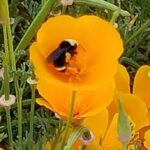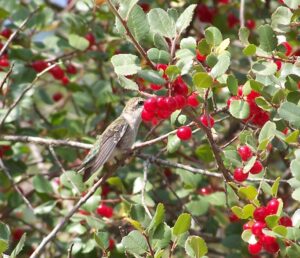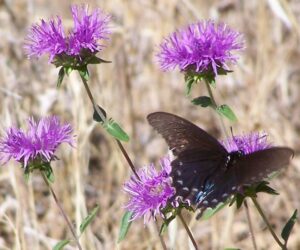By Debbie Arrington
Guest Writer
If you plant it, they will come.
Want to see more birds, bees, butterflies and other wildlife in your garden? Plant what they need for food or habitat. Remember: Native wildlife loves native plants.
Christina Lewis has seen this work firsthand. Director of the SacValley CNPS Nursery and Gardens at Soil Born Farms, Lewis is a big believer in homegrown habitat. Her Carmichael Garden features almost 100 varieties of native plants and nurtures a wide range of wildlife – while saving water, too.
“It’s drought tolerant but so much more,” Lewis says. “There are so many wonderful things that native plants do. If you only focus on the drought-tolerant aspects, you aren’t getting the full picture. Many native plants are also climate resilient, surviving extremes of heat, cold, wind, snow, and more.”
A low-water Mediterranean garden can be decorative, drought tolerant and attract some pollinators, she notes. “But a native garden can do all that plus adapt to climate extremes, restore your soil, cut down on pesticide use and provide wildlife habitat.”
The more varieties of native plants, the more kinds of wildlife. During a recent visit to Lewis’ backyard, that diversity was on full display – especially among the bird population. A flock of magpies splashed in a water feature that doubles as an oversized birdbath. Mourning doves pecked for primrose seeds on the edge of the patio. Scrub jays darted in and out of live oaks. Hummingbirds flitted among bright red California fuchsia.
“The magpies just take over,” Lewis says. “They’re the original clown bird and I love watching them. They’re here because I have what they need.”
Meanwhile, butterflies fluttered among native asters and native bees buzzed from bush to bush. Bushy-tailed gray squirrels busily gathered early acorns and eyed the native grapes.
Everybody enjoyed this bountiful buffet in the middle of suburbia where they could also enjoy shelter and a safe place to make their home.
“What’s really fun is watching the songbirds and the squirrels all hang out together,” Lewis says.
Another point to remember: Wildlife that lives here year-round needs year-round food sources. When planning a native garden, diversity is key – not only in varieties but bloom times. “I try to have something blooming all year,” Lewis says.
Like a woodland, Lewis’ garden has different layers – tall trees (coastal redwoods, live oaks and a silver maple), shorter trees and shrubs (Western redbuds, coffeeberry and button willows) and closer to the ground, blooming perennials (Evening primrose, asters and California fuchsia). An outdoor shower and other creative rain and water collection systems feed extra moisture to the plants that need it such as the redwoods and button willows. The trees, shrubs and deer grass provide shelter to the many birds.
Songbirds greatly benefit from the seeds and berries that native shrubs and trees provide, she notes. Among her favorites: Western redbud, toyon, elderberry, coffeeberry, redberry and buckeye. (The birds like them, too.)
Lewis has several shrubs and trees that serve multiple populations through the seasons. Elderberry flowers, for example, are a spring favorite of native bees, honeybees and butterflies while mature elderberries feed birds in the summer and fall.
Oaks – particularly the deciduous Valley oak or the evergreen California live oak – rank among the best providers for local wildlife. According to Calscape.org, the Interior live oak supported a wide range of birds, insects, small mammals, reptiles and amphibians plus at least 17 species of butterflies and moths. Local live oaks are home to more than 150 species.
Butterfly and moth species require specific host plants.
“Classically, people think of monarch butterflies and milkweeds,” Lewis notes. “But there are many other combinations.”
Dutchman’s pipe vine is the host plant for Pipevine Swallowtail butterfly. Passionflower feeds migrating gulf fritillary. Those caterpillar-friendly plants have another benefit; caterpillars feed birds.
“Caterpillars are such an important source of protein for birds,” Lewis says.
A chickadee chick, for example, needs more than 350 caterpillars a day while in the nest; collecting food is a full-time job for its parents. The birds also serve as a natural control, keeping the caterpillar population in check.
The galls that fall from oak trees contain tiny wasps that feed scrub jays, nuthatches, titmice, sapsuckers and more; they can peck holes in the galls to pick out larvae.
Besides sipping nectar from flowers or feeders, Anna’s hummingbirds – the species that lives in Sacramento year round – eat insects for protein.
With its diversity of plants and wildlife, this suburban garden is its own little sanctuary. “We have an opportunity to bring nature back,” Lewis notes. “The critters didn’t ask for this (loss of habitat), but we’re the only ones that can do anything about it.”
———————————————————————————————————————————-
Debbie Arrington is a longtime home and garden reporter and co-author of the blog Sacramento Digs Gardening: https://sacdigsgardening.californialocal.com
*




